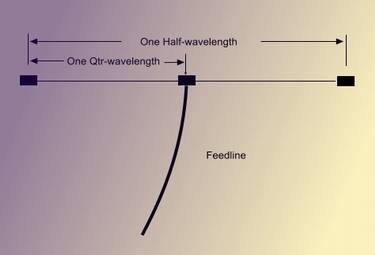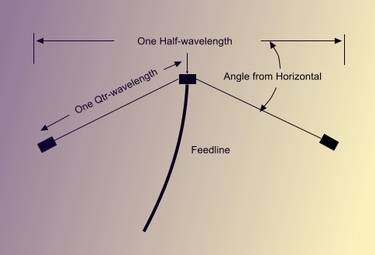Wire Antenna CalculatorThe following program will calculate the lengths needed to construct several popular wire antennas. All you need to do is enter the desired resonant (center) frequency in the form below, then click "Calculate". The correct lengths for the various models will be displayed in the chart. (To better understand the variables be sure to read the application notes and study the drawings, following.) This calculator will accurately compute values for all HF antennas — 1.8 - 30 mHz. Dipoles and Inverted VeesThe basic formula for determining the length of a center fed, half-wave wire Dipole or Inverted Vee antenna is: This formula takes into consideration the capacitive "end-effect" from insulators which shortens the physical length requirement for the equivalent electrical length. The inverted Vee antenna will be shorter by 2 - 5% depending on the angle from horizontal.
The feedpoint impedance of a Dipole in free space is close to 75Ω. Dipoles can be fed directly with 50Ω or 75Ω coax, or with a 1:1 balun at the feedpoint. The slight mismatch when using 50Ω coax can be easily matched with an antenna tuner. More importantly, for symmetrical current distribution, reduced feedline radiation, and thus a cleaner pattern, a balun should always be used at the feedpoint. Due to the proximity to ground at the end of each leg, the feedpoint impedance of an Inverted Vee is very close to 50Ω. Inverted Vees thus can be fed with 50Ω coaxial cable, with or without a 1:1 balun. (The advice regarding the use a feedpoint balun pertains to the Inverted Vee as well.) Both Dipoles and Inverted Vees can be fed with 300Ω or 450Ω ladder or open wire feeders into a balanced Antenna Tuner. This configuration, known as a "Doublet", will work well as a multiband antenna. Flat-Top Dipole or Inverted Vee? As is often the case when given a choice, there are trade-offs involved. The Inverted-Vee requires only one tall support, and less horizontal spread than the Flat-Top Dipole. It is also a very close match to 50 Ω coax. On the other hand there is some loss of gain because the pattern is less directional, and the bandwidth is narrower than the the horizontal dipole. CONSTRUCTION NOTES: Half-wave Dipoles and Inverted Vees are very easy to construct, and are great for homebrew projects. You may purchase commercially made end insulators and center insulators with coax connectors built in, but why not make it truly homebrew and make your own hardware? It is quite easy using schedule 40 PVC pipe. Admittedly, if you are going to use a balun at the feedpoint, purchasing a center insulator with the balun built in is certainly a lot less work! If you decide to roll your own, be sure all connections are secure, both mechanically and electrically. Be sure to properly solder all joints and to use weatherproofing. Remember to provide some type of strain relief at the center insulator for your "dangling" feedline. Not only does the feedline represent a strong downward tug, but when the wind blows the mechanical stress on your connections increases dramatically. A good strain relief system is to wrap the feed cable once around the center insulator and secure it with "UV-Resistant" (usually black) tie-wraps. You will, of course "invent" something much more sophisticated for your design! Suitable feedline can be 50 Ω coax, such as RG-58, RG-8X, RG-8, RG-213, or 75 Ω types such as RG-11, RG-59, RG-6, or even 75 ohm twin lead. Believe it or not, even zip cord (lamp cord) will perform quite well. Of course you need to "size" your feedline according to the power you intend to run. Power in excess of 200 watts can develop very high RF voltages. Be sure your feedlines and antenna hardware can handle the power. In the real world — where you build your antennas — the actual impedance of your wire antennas will depend on several variables. i.e. height above ground, proximity to large, especially metalic, objects, and proximity to other resonnant antennas. Always cut your antenna lengths a bit long. This will allow you to "fine tune" the antenna by trimming. You will quickly learn that "trimming" is a LOT easier than "adding to"! When you decide where to "hang" your antenna, remember that the horizontal radiation pattern of a Dipole in free space is a wide "Figure-8", which radiates perpendicular to the axis of the dipole. The vertical radiation pattern depends on the height above ground. As stated above, to be an effective DX antenna, a low-angle signal take-off is required, and that means your dipole must be at least one-half wavelength above ground. If you choose to build an Inverted Vee, be sure the angle of the sloping legs is not more than 45 degrees (the inside angle at the feedpoint is not less than 90 degrees). If you increase the slope more than this, the Inverted Vee will begin to act like a vertical monopole with an omnidirectional radiation pattern. Finally, don't fret about fractional parts of an inch when using the measurements from the calculator above. At HF frequencies, an inch is such a small part of a wavelength that it is a non issue. Full Wave LoopsThe basic formula for determining the length of a full-wave wire Loop antenna is: Since closed loops are not subject to "end-effect" the calculated physical lengths with this formula are longer than corresponding dipole dimensions and are close to free space dimensions. Since the loop dimensions are larger than those of a half-wave dipole, the radiation efficiency is also higher.
The feedpoint impedance of a full-wave loop in free space is aproximately 100-120 Ω with a gain over a dipole of 1.35 dB. In the real world, installed at practical amateur heights (physically close to ground), the range of feedpoint impedance can be from 50-240 Ω depending on configuration, orientation, and choice of feedpoint. One of the realities that comes with choosing a full-wave loop is the need for some type of feedpoint matching system. If you study the literature you will discover a near endless array of configurations for a full-wave loop. You can choose a square or diamond, equilateral triangle with apex up or down, feedpoint on the bottom, side, corner... All these "adjustments" affect the feed impedance, gain, polarization, pattern, and of course, the support structure requirements. For our purposes, we will limit this discussion to two configurations, both optimized for certain HF bands. 1.) the bottom-fed quad loop is a very good choice for the 20-10M bands. It has the highest gain at low take-off angles, and the horizontal polarization is great for these frequencies. 2.) The off-corner fed, equilateral delta is a solid performer on the amateur frequencies below 20M. With its low angle take-off, vertical polarization, and single support requirement, it is a great choice for low band DXers. Study the literature. You may find another configuration more suited to your requirements. At take-off angles of interest to DXers, the full-wave loop's horizontal radiation pattern in free space is a wide "Figure-8" which radiates perpendicular to the plane of the loop. Interestingly, at very low angles, some radiation from the delta loop is endfire... that is, parallel with the plane of the loop. Of course, to acheive such low angles would require the entire loop to be mounted at least 1/4 wavelength above ground. That would be quite a challenge at 3.5 and 1.8 mHz! CONSTRUCTION NOTES: Because of their size, full-wave loops present additional challenges to the builder. Basically, all the dipole construction notes above, pertain to loop construction as well. There is no substitute for good engineering practice, and common sense still rules the day. There are however, a few considerations unique to the loop. Because of the large size of low frequency loops, the length of the feedline represents a significant load on the wire element. This is especially true for high power levels when larger coax is required. You should carefully design the feedpoint mechanics for strength. One solution which solves two design issues, is to use heavy duty ladder line, and feed the antenna through a balanced antenna tuner. This solves the weight problem as well as the need for a feedpoint matching system. If you don't have a sufficiently tall support structure for a full-wave loop, don't despair. There is significant emperical testimony to the efficacy of a low-to-the-ground, sloping delta loop. Modeling will confirm a 1-3 dB gain in directivity in the direction of the slope. All-in-all, full-wave loops are very good antennas. If you feel like experimenting, or if your low-band antenna farm needs a bit of improvement, by all means try a loop. (I personally know of a real-estate challenged ham that worked 20M DXCC running 100 Watts with a single element quad loop nailed to the side of his house. - ed.) If you always wanted to try 80M, here's your chance. Remember... even a lousy antenna is better than no antenna! Back to Articles by WS6X
Back to WS6X Home
Questions?As always, if you have any questions about ham radio, please drop me an email: Jim - WS6X. I would be honored to help
in any way I can. I may even be able to help locate a ham radio operator near you, so you could get a first-hand look!
Copyright © 2006-2025, Jim Clymer, Jr. |
|



